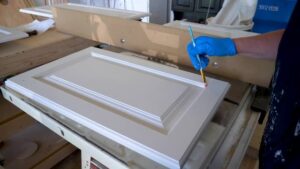Gutter Cleaning Charleston SC is an important home maintenance task that prevents clogged gutters, which can lead to water damage inside the house. It also helps in preventing landscape erosion and foundation problems.

Cleaning out your own gutters is often cheaper than hiring a professional to do the job, but it comes with risks like ladder falls. A professional will be more experienced in working on high ladders.
Gutter cleaning is an important part of overall home maintenance, as gutters and downspouts protect the house from water damage. Clogged gutters cause water to overflow and can damage the fascia boards, siding, foundation, and basement of your home. Regular inspection and cleaning will prevent these problems. A clogged gutter may also be a sign of an underlying roof problem, like damaged shingles or flashing. In such cases, it’s recommended to hire a professional for gutter cleaning and other roof and exterior home maintenance services.
During gutter cleaning, the first step is to remove any visible debris. It is then necessary to clean the gutters with a hose or bucket of water. This will wash down any finer particles and help to stimulate rain or water flow. It is also recommended to use a plumber’s snake to dislodge any clogs. Always make sure to follow safety protocols during this process, and always use caution when working at heights.
In addition to cleaning the gutters, it is important to test them by running water through them. This will ensure that the clog has been completely cleared and that the downspouts are functioning properly. In addition, it will help to identify any rust or other signs of damage to the downspouts and gutter system.
If you suspect that your gutters or downspouts are clogged, it is a good idea to use an enzyme-based cleaner. This product works by breaking down organic material like leaves, twigs, and tree sap over time. This is an environmentally-friendly alternative to harsh chemical drain cleaners, and will not damage your gutters or downspouts.
When choosing a gutter cleaning company, be sure to ask about their safety standards, licensing, and insurance. This will help you to choose a reputable company that has the proper equipment and training to do the job safely. Also, ask how long they typically take to clean the gutters and how many people they have on their crew. This will give you an indication of how experienced and skilled they are at their craft. In addition, be sure to read reviews from past customers to get a better sense of what to expect.
Cleanliness
Gutter cleaning is one of the most important tasks to perform in order to protect a home from foundation issues and water damage. However, this task is not as simple as it may seem and can be dangerous for anyone not familiar with proper ladder safety and cleaning techniques. If done improperly, it can lead to serious injury or even death.
To avoid these risks, it’s best to hire a professional to clean your gutters. They can use a telescopic gutter cleaning pole to thoroughly remove debris and ensure that no part of the gutter remains clogged. In addition, they can also help to revive the appearance of your gutters and fascia by using special detergents.
Keeping gutters clean is essential for many reasons, including protecting the roof and foundation of your house from water overflow and preventing the growth of moss, lichen, tree seedlings, and other invasive plants. Additionally, it is important to keep gutters free of debris to prevent the buildup of silt and mud, which can cause foundation cracks.
Clogged gutters can also be dangerous for your family’s health as they allow rainwater to seep into the walls of your home and create mold spores. If the mold spores are not removed, they can trigger respiratory problems and other health issues. Gutter cleaning should be performed regularly to avoid these risks.
Regular gutter cleaning can help to prevent pests like rats, ants, and mosquitoes from breeding in them, which can spread deadly diseases. It also eliminates the organic matter that supports the growth of weeds, fungus, and tree seedlings.
Another way to keep your gutters clean is to trim any overhanging branches and trees that are causing debris to fall on the roof. This will also make the job of cleaning your gutters much easier and faster.
The ideal frequency of gutter cleaning depends on the environment in which your house is located and how often your roof gets a lot of debris. For instance, if your home is surrounded by trees with thick branches that fall leaves throughout the year, you should clean your gutters more frequently than a house in a less tree-heavy environment.
Safety
A well-maintained gutter system helps to protect the foundation of your home and prevents overflowing and rot. It also provides a clear path for water to drain and avoid roof damage, which can occur if the gutters are clogged. Clogged gutters can also promote the growth of mildew and mold, which can be harmful to your family’s health. To ensure your safety, it is a good idea to hire a professional gutter cleaning service.
Gutter cleaning requires the use of a ladder and specialized tools. You should wear protective gear, including non-slip footwear and gloves. It is also a good idea to have a bucket, a gutter scoop, and a rake for collecting debris. In addition, you should have a garden hose with a nozzle attached to the end of the ladder. You should also choose a sturdy ladder with stabilizer arms, which attach to the side of the ladder and help to keep it from tipping.
It is important to wear gloves when performing gutter cleaning, as the debris can contain a variety of bacteria, including bird, pigeon, and squirrel feces. Additionally, the debris can be very dirty and can irritate your hands. You should also wear eye protection to protect your eyes from shards of metal and other items that might be in the debris.
The best time to clean the gutters is in the late morning or early afternoon, when the sun is low and will not glare off the water. It is also a good idea to place a tarp beneath the work area, as it will catch any fallen debris and prevent damage to the landscaping. Before climbing a ladder, it is a good idea to survey the area and be aware of any potential hazards, such as power lines or tree branches that could fall on you while you are working.
A professional gutter cleaner has the tools, equipment, and skills to clean the gutters quickly and efficiently. They can also identify problems with the gutters and recommend repairs. This can save you a lot of time and money in the long run.
Cost
When you hire a professional to clean your gutters, they will also inspect them for obstructions. This helps ensure that the gutters are properly channeling water away from the foundation. In addition, it will help identify any sagging or other problems that require repair or replacement. This prevents future issues and reduces the cost of gutter maintenance. Generally, cleaning and inspection costs are included in the overall cleaning price.
The most significant factor in the cost of gutter cleaning is labor. Skilled professionals with the proper equipment for working at heights can command high rates, especially in urban areas where labor is more expensive. Gutter cleaning companies typically add on a percentage or flat fee for travel distances to compensate for fuel and vehicle wear and tear.
Another major cost driver is the length of gutters, which are measured in linear feet. Longer gutters are more difficult to reach and require more time to clean than shorter gutters. Additionally, a multistory house may require specialized equipment like extended ladders to access the gutters.
Clogged or overflowing gutters can result in damage to the roof, fascia boards, and home exterior. The debris that accumulates in the gutters can even cause shingles to curl and buckle. This is why it is important to have your gutters cleaned regularly. Professionals have the tools and knowledge to quickly and safely remove clogs, clean out the gutter system, and flush the gutters with high-pressure hoses.
In some cases, it may be necessary to install additional downspouts to handle heavy rains or to address other drainage issues. This can add an additional $50 to $100 per downspout to the total cost of the project.
It is important to hire a licensed and insured company when hiring a gutter cleaning service. While anyone with a ladder and truck can call themselves a gutter cleaner, many of these unlicensed individuals may lack the training or experience to provide safe and effective services. A licensed and insured company will likely be a little more expensive than a weekend warrior making some extra cash, but they will be able to provide you with the best value for your money.


